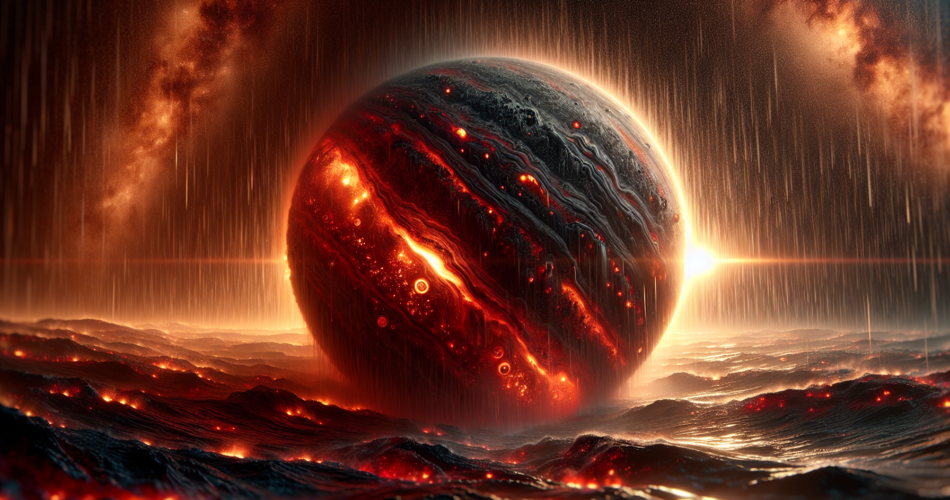The exoplanet HD 189733b has captured the imagination of scientists and astronomers alike due to its extreme weather conditions, characterized by sideways rain of molten glass. Located about 64 light-years away in the constellation Vulpecula, this hot Jupiter-type exoplanet presents an environment that defies our conventional understanding of planetary atmospheres. The combination of intense heat, high-speed winds, and unusual meteorological phenomena raises questions about the conditions that can exist on distant worlds, challenging our definitions of habitability and planetary dynamics.
Unraveling the Phenomena of Molten Glass Rain on HD 189733b
On HD 189733b, the atmospheric conditions are unlike anything found on Earth. The planet orbits its host star at a blistering distance, resulting in surface temperatures soaring well over 1,000 degrees Celsius (1,832 degrees Fahrenheit). This extreme heat vaporizes silicates in the atmosphere, which subsequently condense into tiny droplets. As these droplets are propelled by supersonic winds that can reach speeds of over 7,000 kilometers per hour (about 4,350 miles per hour), they are driven sideways, creating the strange phenomenon of molten glass rain.
The composition of the atmosphere on HD 189733b is primarily made up of hydrogen and helium, interspersed with clouds of silicate. These clouds contribute to the vicious weather patterns, with wind speeds so high that they can transport and condense the silicate vapor into liquid glass. Observations from space telescopes have provided critical data, allowing researchers to model the atmospheric dynamics of this exoplanet and better understand the processes that lead to the formation of molten glass rain. Furthermore, the peculiarities of its weather system underscore the diverse and extreme conditions that can exist in the universe.
This unique weather phenomenon serves as a reminder of the astonishing variety of planetary atmospheres beyond our own solar system. HD 189733b exemplifies a class of exoplanets where traditional Earth-like weather patterns are rendered obsolete. By studying the extreme weather conditions on this exoplanet, scientists can gain insights into the broader implications of atmospheric science and climatology across the cosmos, offering a glimpse into the potential for other exotic phenomena on similarly extreme worlds.
The Implications of Extreme Weather on Exoplanetary Studies
The extreme weather on HD 189733b has significant implications for the field of exoplanetary studies. First and foremost, it challenges our understanding of what constitutes a planet’s habitability. Previously, habitable zones were thought to exist within specific temperature ranges conducive to liquid water; however, findings from HD 189733b suggest that conditions can diverge dramatically from this model. The ability to study such extreme environments may lead to a reevaluation of how we determine the potential for life beyond Earth.
Additionally, the study of HD 189733b’s weather patterns can enhance our models of atmospheric dynamics applicable to other planetary bodies. The extreme wind speeds, coupled with the ability to form molten glass, provide valuable data points for researchers seeking to understand the underlying mechanics of planetary atmospheres. This knowledge could be useful for interpreting the atmospheres of similarly hot Jupiters and even rocky exoplanets that may be subject to extreme weather phenomena, thus broadening our theoretical framework for exoplanet characterization.
Moreover, the exploration of extreme weather on exoplanets like HD 189733b opens up new avenues for technological advancement. As researchers develop instruments capable of observing and analyzing such distant and inhospitable environments, they also push the boundaries of what is possible in terms of observational astrophysics. This can lead to innovations in telescope design, imaging technologies, and data analysis techniques, ultimately enriching our understanding of the universe and our place within it.
The case of HD 189733b, with its sideways rain of molten glass and extreme weather conditions, serves as a fascinating example of the complexities and wonders of planetary atmospheres beyond our own. As our observational capabilities advance, the implications of such extreme environments will continue to challenge our preconceptions about habitability and the diversity of planetary systems. The study of HD 189733b not only contributes to our understanding of exoplanets but also inspires a new generation of scientific inquiry into the nature of weather, climate, and life throughout the cosmos.

